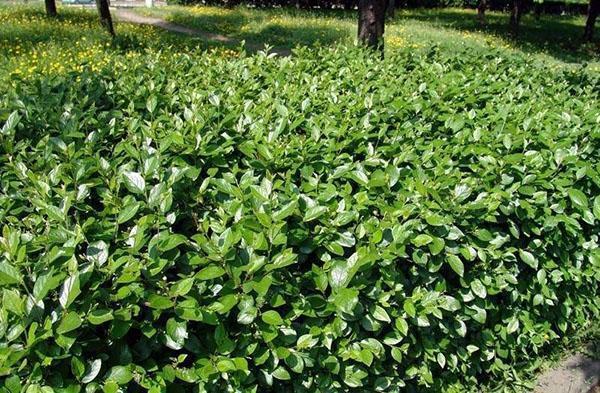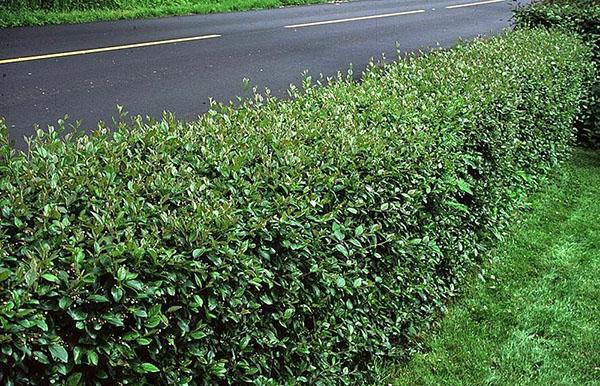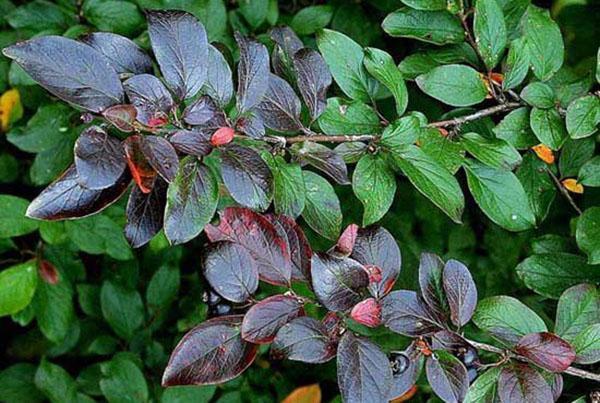A great idea for a hassle-free hedge - the cotoneaster is shiny
 Cotoneaster belongs to a valuable genus of ornamental shrubs that are widely used in the arrangement of gardens and parks. The hedge from the brilliant cotoneaster is most widespread, thanks to the unpretentiousness of the variety, the slow growth rate and the dense green crown, which lends itself well to shearing. In spring and summer, the plant pleases the eye with lush and dense foliage of a dark green hue, which falls off by winter. Autumn paints the cotoneaster with the brightest colors - yellow and orange, red and burgundy. Such a hedge always looks spectacular and unusual!
Cotoneaster belongs to a valuable genus of ornamental shrubs that are widely used in the arrangement of gardens and parks. The hedge from the brilliant cotoneaster is most widespread, thanks to the unpretentiousness of the variety, the slow growth rate and the dense green crown, which lends itself well to shearing. In spring and summer, the plant pleases the eye with lush and dense foliage of a dark green hue, which falls off by winter. Autumn paints the cotoneaster with the brightest colors - yellow and orange, red and burgundy. Such a hedge always looks spectacular and unusual!
Brilliant cotoneaster - characteristics and description of the variety

Cotoneaster is a long-liver; in one place a bush can grow for over 50 years.
Description of the variety Brilliant cotoneaster:
- Foliage. The leaf is simple, small, dense, smooth, dark green in color, its shape is oval and elongated. In autumn, foliage falls, but there are evergreen varieties.

- Flowers. The shrub blooms from the end of May to the end of June, the inflorescences are small in size, delicate pink in color, have a pleasant smell. Flowers look elegant and beautiful against the background of lush green foliage.

- Fruit. The bush bears fruit from the fourth year of life, the fruits ripen in September. The cotoneaster bears fruit with glossy spherical berries and black color without any special taste, some people use them for medicinal purposes.

When deciding to create a hedge on your site, the brilliant cotoneaster cannot be ignored here. Its dense foliage looks like a solid wall, suitable for any landscape and attractive at any time of the year.
Advantages and disadvantages of a hedge cotoneaster
 Photos of a hedge from a brilliant cotoneaster are interesting and original, they attract the eyes. Gardens and household plots are zoned with a cotoneaster, they frame flowerbeds and lawns, and they decorate multi-level landscape compositions. It is planted along garden paths and curbs, and allowed on fences and fences.
Photos of a hedge from a brilliant cotoneaster are interesting and original, they attract the eyes. Gardens and household plots are zoned with a cotoneaster, they frame flowerbeds and lawns, and they decorate multi-level landscape compositions. It is planted along garden paths and curbs, and allowed on fences and fences.  The cotoneaster hedge looks beautiful, harmonious, bright and neat! On a solid green background, any tall and low tree will be successfully located, a flower bed will look spectacular, water, rockery or alpine slide.
The cotoneaster hedge looks beautiful, harmonious, bright and neat! On a solid green background, any tall and low tree will be successfully located, a flower bed will look spectacular, water, rockery or alpine slide.
 Advantages of a brilliant cotoneaster in hedge format:
Advantages of a brilliant cotoneaster in hedge format:
- Appearance. The beauty and juiciness of the brilliant cotoneaster hedge is the main advantage appreciated by gardeners of all countries.
- Growing conditions. The cotoneaster takes root on any soil, is not afraid of drought and excess moisture, is resistant to frost and winds, and easily tolerates urban living conditions.
- Requirements. The shrub is well adapted to harsh climatic conditions, is not afraid of shade, grows on rocky and poor soils, while maintaining high decorative qualities.
- Features of care. The plant adapts well to any terrain, the cotoneaster is not picky about care, watering and feeding.The only caveat is the need for regular decorative pruning of branches. Only under the condition of a systematic haircut will the hedge please with its ideal shape and neatness.

- Diseases and pests. In early spring, as a preventive measure, the cotoneaster is treated with insecticides. The plant is susceptible to fungal diseases, the necessary measures are the treatment of bushes and soil with fungicides, urgent pruning and burning of affected branches.
With the help of scissors, cotoneaster bushes can be given any shape and contour, but the most popular are the trapezoid, rectangle and ball. A group of bushes can be combined together to create an unusual green shape out of them.
Planting and caring for a cotoneaster as a hedge
 The planting time for hedges depends on the seedlings. With open rhizomes, the optimal period will be spring or autumn - March and April, or September and November. If plants with a closed root system are used, then the timing of their planting is not limited - from early spring to late autumn, so that by winter the shrubs have time to take root and get stronger.
The planting time for hedges depends on the seedlings. With open rhizomes, the optimal period will be spring or autumn - March and April, or September and November. If plants with a closed root system are used, then the timing of their planting is not limited - from early spring to late autumn, so that by winter the shrubs have time to take root and get stronger.
 How to plant a hedge cotoneaster:
How to plant a hedge cotoneaster:
- a high and thin hedge requires a single-row planting of at least three seedlings per linear meter of land, the average height of a bush is 1-1.5 meters;
- the scheme of planting a cotoneaster for a low-height hedge is 4-5 bushes per linear meter, planted in two rows in a checkerboard pattern, alternating at 40 or 50 cm, three rows are not recommended.
 Caring for a cotoneaster hedge will not be difficult. Additional watering is required only in hot and dry weather. To improve root respiration, plants need weeding and loosening, as an alternative - soil mulching around the trunk. If the winter period is characterized by severe frosts, then for the first winter, it is recommended to cover the cotoneaster fence with dry foliage, coniferous or burlap.
Caring for a cotoneaster hedge will not be difficult. Additional watering is required only in hot and dry weather. To improve root respiration, plants need weeding and loosening, as an alternative - soil mulching around the trunk. If the winter period is characterized by severe frosts, then for the first winter, it is recommended to cover the cotoneaster fence with dry foliage, coniferous or burlap.
Planting a hedge cotoneaster - steps:
- Planting holes are dug under the root for approximately 2 bayonets of a shovel - from 50 to 70 cm deep and the same width.
- The bottom of the pit under the root is covered with gravel or expanded clay for high-quality soil drainage.
- The shrub grows successfully on different soils, but the ideal composition for it is 2 parts of sod soil and sand, 1 part peat.
- If desired, compost can be added to the ground, fertilizers can be omitted.
- Seedlings are planted according to the chosen scheme, at first they need sufficient watering.
Forming a hedge from a brilliant cotoneaster
 The growth rate and quality of the foliage, the density and density of the branches of the brilliant cotoneaster allow you to successfully experiment on it with different shapes, outlines and variations. Do not be afraid to try your hand at being a gardener - it's interesting, easy and exciting!
The growth rate and quality of the foliage, the density and density of the branches of the brilliant cotoneaster allow you to successfully experiment on it with different shapes, outlines and variations. Do not be afraid to try your hand at being a gardener - it's interesting, easy and exciting!
Rules for cutting a hedge from a brilliant cotoneaster:
- work on the formation of a hedge is carried out with a brush cutter or trellis shears;
- crown molding begins when the shrub reaches a height of 50-60 cm, this is about two years of plant life;
- in early spring, before bud break, a thorough sanitary pruning should be carried out;
- first, the bush is cut off from above, this gives an impetus for better growth of side shoots;
- young branches are not cut by more than 1/3 of their length;
- autumn seedlings are not cut for the winter;
- the optimal frequency of haircuts is from 2 to 3 times a year;
- annually, the height of the bushes is increased by 5-8 cm until the hedge reaches the desired height;
- a complex contour is cut along tight ropes or using a template made of wooden blocks.
 The cotoneaster, shining like a hedge, is traditionally planted in public urban areas - near administrative buildings, cultural and social institutions. It is successfully used for planting on slopes and slopes, its strong root system does not allow soil collapse and shedding.It is often used in stepped landscape design and as a decoration for flower beds. Variety of options and solutions, but one plant - the famous and affordable cotoneaster!
The cotoneaster, shining like a hedge, is traditionally planted in public urban areas - near administrative buildings, cultural and social institutions. It is successfully used for planting on slopes and slopes, its strong root system does not allow soil collapse and shedding.It is often used in stepped landscape design and as a decoration for flower beds. Variety of options and solutions, but one plant - the famous and affordable cotoneaster!
Hello! I would like to buy a cotoneaster. Please tell me how much is one bush? Thank you in advance! Excuse me, what photo do I need to upload?
We do not sell plants. Check with your nearest nursery or gardening center.
Good day! I have a brilliant cotoneaster that has been growing for 4 years already, it just so happens that I need to transplant it, ALL LIVING HEDGE. How deep you need to drip so as not to damage the roots. can give some advice on the transplant. thank
The cotoneaster has a fibrous root system. When digging up a bush, be guided by the fact that its roots go into the ground to a depth of about 50 cm. It is better to transplant in the spring, such an adult plant can hurt more if you do it now.
Our cotoneaster is the third year. Is it possible to trim the cotoneaster in early September? This was not done in the spring and summer.
Plants should be trimmed after the air temperature drops to + 10 ° С. Previously possible, but not desirable.